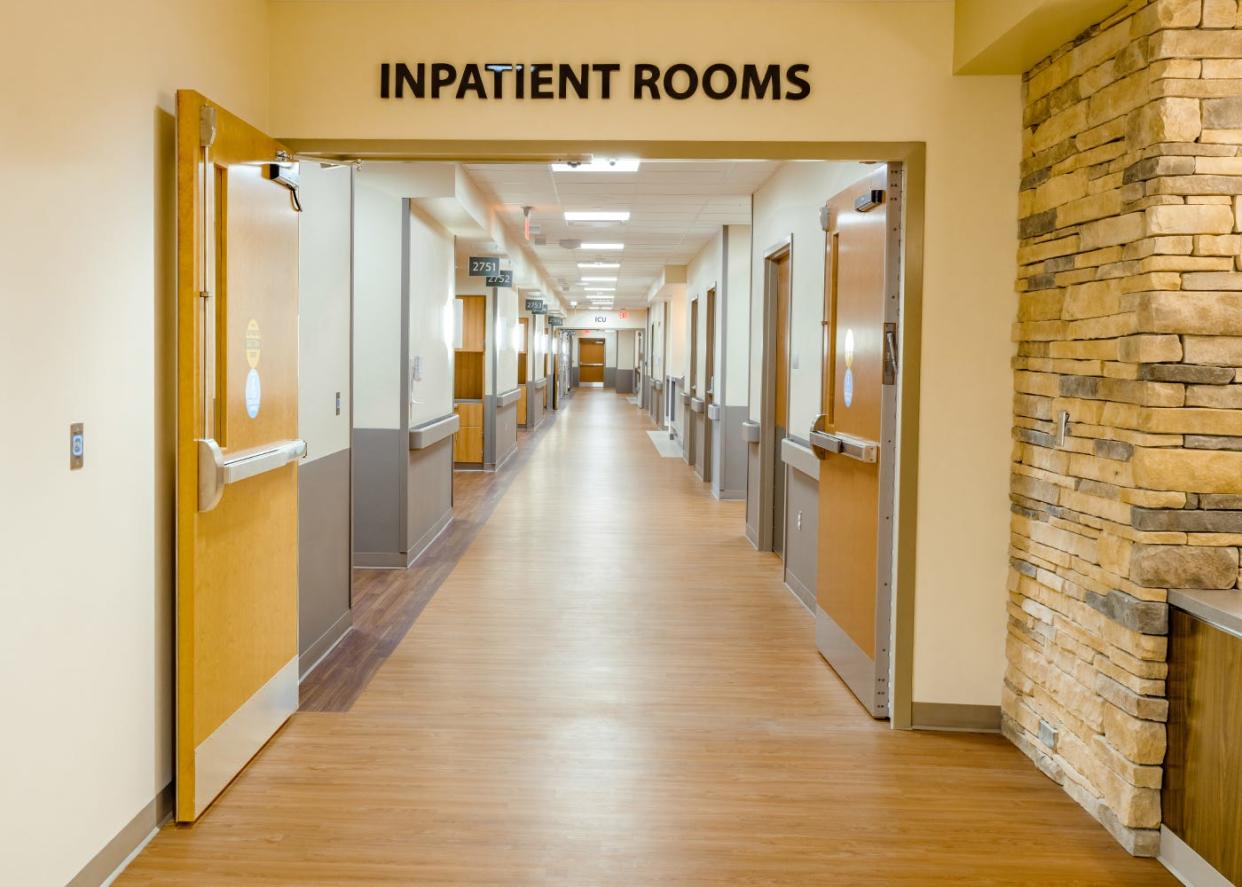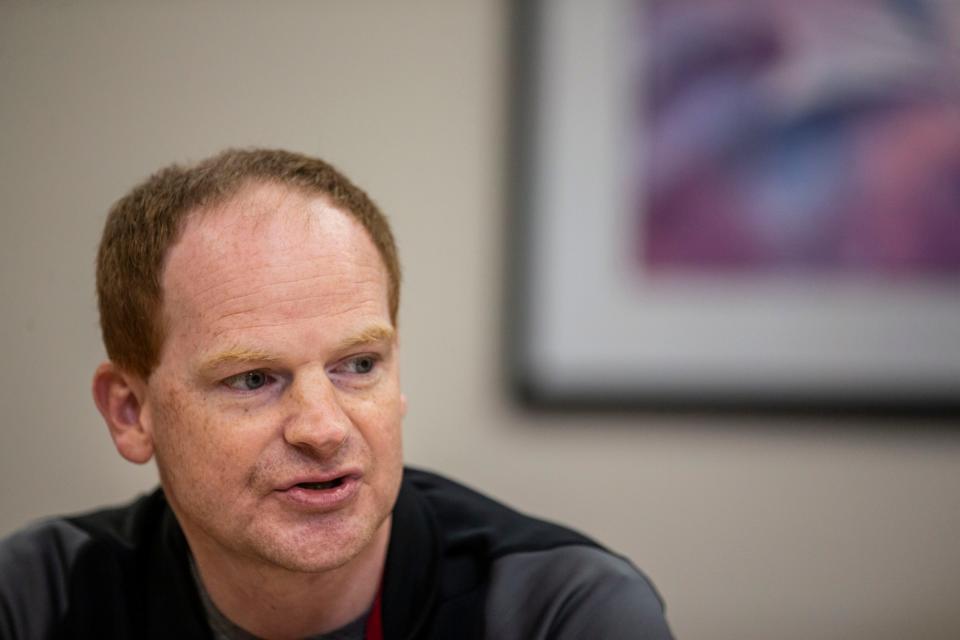Inside University of Louisville Hospital, staff see how bullets 'crush' victims, families

LOUISVILLE, Ky. — The sudden voice from the intercom in the University of Louisville Hospital's emergency department is brief.
"Room 9."
The message may not mean much to visitors, but the surgeons, nurses and hospital staff for the Louisville region's main trauma center know exactly what it portends.
Another person seriously wounded or dying — very possibly from a bullet, or two or three, ripping through their body.
Last year, more than 800 people were shot in Louisville, or roughly two shootings per day. This year, nearly 200 people have been injured in nonfatal shootings in addition to over 80 killed in homicides through mid-June.
"It’s heartbreaking to see what’s happening in our city every day," Dr. Keith Miller, a trauma surgeon at U of L Hospital and assistant professor in the U of L School of Medicine's surgery department, told The Courier Journal during a visit last fall.
Tracking Louisville's violence: The latest on the city's homicides
But "this is what we all signed up to do," Miller added. "This is what we’re here for."
Other than a quick debriefing on the wounds, the ER staff often know little about the people they treat — even their name or what happened in the moments before they were shot.
They work quickly, with several team members operating on a shooting victim while others jot down notes and record patient information.
The room is a scene of calm, efficiency and occasional chit-chat from those who aren't working feverishly on the patient. This is, after all, something these doctors and nurses do every day.
“It’s kind of like a valet — everybody doing what they’re supposed to do,” one doctor told a reporter who was watching his team at work.
In serious trauma cases, a "Level 1" activation is sent.
The trauma team members at U of L Hospital wear pagers that transmit a message like "911-5," which means a Level 1 patient is estimated to arrive in 5 minutes.
U of L growing: University of Louisville Health set for major expansion to treat more patients
The Level I criteria include patient conditions such as a systolic blood pressure of less than 90, “respiratory compromise” or the need for “blood resuscitation to maintain vital signs during transport.”
There's another Level 1 criteria that is an all-too-familiar sight in the ER: “Gunshot wound or severe penetrating injury to neck, chest and/or abdomen.”
Given that Louisville saw a record 175 fatal shootings and 630-plus nonfatal shootings in 2021, Room 9 at U of L Hospital has seen its fair share of Level 1 cases.

"Every injury impacts the individual, their family and the individual's community," Miller said.
U of L Hospital sees most of the gunshot and severe trauma patients in Kentucky and Southern Indiana, with Norton Children's Hospital in Louisville as well as Chandler Hospital and Kentucky Children's Hospital in Lexington the only other Level I trauma centers in the commonwealth.
That means some patients arrive at U of L Hospital from rural areas far away from Louisville, and in those cases, minutes and even seconds can mean everything.
Stemming the bloodshed: Louisville pays steep price for underfunding violence prevention. Did it learn its lesson?
It can take hundreds of people throughout the health care system to care for just one "acutely injured patient," Miller said.
And beyond the emotional toll on families, each fatal shooting in Louisville with one suspect can cost taxpayers about $900,000 and the city over $100 million in a year, according to a National Institute of Criminal Justice Reform report.
Rooms at the ready
The team in Room 9 helped figure out where the gunshot patient one morning needed to go next, part of what Miller called a "shot clock."
Of the patients rushed into the ER, Miller said 65% will require "major operations" and monitoring.
The "shot clock" could include whisking the patient out of Room 9 and through one set of doors to nearby room for a CT scan, or upstairs to an operating room or the intensive care unit, or, in best cases, to a recovery room.
For more extensive care, the team can move within 1 to 2 minutes from Room 9 to Room 4, a bigger operating room on an upper floor that is open 24/7 for serious cases.
A board on the wall across the room is dedicated to the "Patient Safety Checklist."
Miller notes a trio of "operative objectives" for his team and the residents in training who learn and work at U of L Hospital: Save a life. Minimize morbidity. Anticipate trouble.
During particularly busy times at the hospital, multiple gunshot patients may require staff to turn other rooms into "Room 4" so more operating space is available, Miller said.
Seeing 'the spectrum of emotions'
Downstairs by the ER, two private rooms offer space for parents, siblings and other relatives to await news on the status of their loved ones.
While doctors and nurses tend to a gunshot victim inside Room 9, the area in and around the family waiting rooms can sometimes be a place where lives are "shattered," Miller said.
"Over the years, oh God, some of the anger, denial … (we've) seen the spectrum of emotions," Miller said, recalling in particular the flood of distraught families at the hospital in 2011 after a deadly shooting at a Shawnee Park kickball tournament.
But Kiara Smith and the two other community health workers at U of L Hospital are here to lend support to the families and update them on what is happening.
"I'll go out there and I'll just communicate and update the family on the status of their loved one and also a medical provider will come out to talk to them, so it just kind of keeps the worry down," said Smith, who had worked for more than three years in her position funded through a partnership with the city's Office for Safe and Healthy Neighborhoods.
"You’ll see a lot of families shocked and surprised … unsure of what’s going on," Smith continued. "Just providing comfort and then reassurance that someone will be able to talk to them and update them shortly, I think it kind of decreases the range of emotions that you may experience."
Krista Gwynn and her husband, Navada, were feeling the worst type of deja vu when they rushed to University of Louisville Hospital last June. Their daughter, Victoria, and her friend, DaJuan Coward, were shot when gunfire broke out in Ballard Park.
Victoria, 19, survived. DaJuan, 17, did not.
Related: US Supreme Court hears about Louisville teen's experiences with gun violence
While receiving treatment at the hospital for her leg injury, Victoria made an urgent plea to staff to see her parents, since she had not been able to be with her brother, Christian, when he was fatally shot in December 2019 while walking home with a friend.
Krista Gwynn said they had to wait for doctors to stabilize Victoria before allowing the family to reunite in her treatment room and give thanks that the teen would survive. Even so, the bullet that hit her leg would lead to months of therapy and recuperation that continues to this day.
"They were on the job, on the money and as respectful and helpful as possible," Krista Gwynn said of the hospital staff. "They kept me updated. Every time we asked a question, they answered it."
Staff even let Victoria move in a wheelchair to the ICU, where DaJuan was spending his final moments.
"That was very appreciated because my daughter ... wanted to say her goodbyes because she didn’t get to say bye to her brother," Krista Gwynn said, her eyes welling.
The health workers also can refer family members to resources like the hospital's Pivot to Peace program, which links shooting and stabbing victims to case workers and other community services to try to help them recover.
Sometimes, a family member will take out their anger over a loved one's serious or fatal condition on Smith and her coworkers.
But they cannot "take those moments personally," she said.
"I've held people when they're crying, and I've held people when they are getting the bad news," Smith said. "They are going through the worst day of their life, so just being there (helps)."
While at Target, Kroger or Dairy Kastle, she has also been stopped patients or family members of patients whom she had helped while in the hospital. They gave her hugs and smiles each time, she said.
"Those days," Smith said, "make it worth it."
The sustained levels of violence in Louisville leave some patients continuing to feel afraid long after they've left the hospital, Miller said.
And it's tough for hospital staff to feel like they are making a difference when patients die from their gunshot wounds, he added.
But if "all of us feel like we did all of what we could," Miller said, "you feel like you did your job."
The bullets harming hundreds of people, young and old, in Louisville also indirectly harm the broader community, the surgeon concluded.
"Bullets don’t cut," Miller said. "Bullets crush and cavitate out to the community."
Reach Billy Kobin at bkobin@courierjournal.com.
This article originally appeared on Louisville Courier Journal: University of Louisville Hospital staff deal with record gun violence

